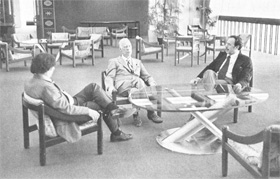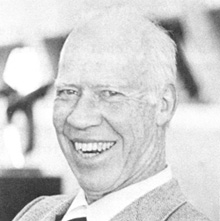Finding Fermilab's Roots
"The older you get, the more interested you are in history." Appropriately, the speaker was William Brobeck, a history-maker in accelerator engineering. He shared 40 years of experience here recently in a quarterly engineering lecture series.
Tapes were made of Brobeck's remarks, for another project, by a new Fermilab History Committee. Finding Fermilab's roots-and particle accelerator origins--is the committee's mission as the laboratory approaches its 10th birthday.
An offshoot of a library committee, the unit was born at a luncheon meeting held in January. Members are: Dr. Robert R. Wilson, laboratory director, chairman; Dr. Drasko Jovanovic, deputy department head-research; Dr. Francis Cole, accelerator division (advanced projects); Dr. Richard Carrigan, assistant department head-research; Dr. Lee Teng, associate department head for advanced projects-accelerator division; and Roger Thompson, head of technical information-administrative division.
Collection materials are expected to include experimenters' papers, cassette/video tape interviews, books, photographs and equipment from Fermilab experiments.
A room in the library is being prepared to house the collection. History committee efforts will be coordinated with the American Institute of Physics' History of Physics Center, New York City, to avoid duplication. Stephen Weart and Joan Warnow, director and assistant director of the center, met here recently with history committee members to discuss the project.
During Brobeck's visit, he gave several lectures and a luncheon interview. These were taped and will launch lab collection materials. The speaker, president of Brobeck and Associates, a Berkeley Calif., consulting firm, served as assistant director and chief engineer at the University of California-Berkeley Radiation Laboratory from 1937 to 1957.
Recorded interviews and/or transcripts will be added as they become available.
Brobeck recalled that public interest in physics and science was sparked by the atom bomb. Radar and microwave technology also came out of World War II, Brobeck said, offering new vistas that engineers realized they didn't know about.
Many engineering jobs were created and physicists became engineers as big science projects were undertaken in the post-war 40's.
Motivation and functions provide the basic differences between scientists and engineers, Brobeck said. Scientists are inspired by curiosity and the search for timeless truths; engineers want to build something that accomplishes a task, makes something happen, the speaker said.
While scientists seek to acquire and organize knowledge, the engineer-researcher seeks knowledge that gets a job done, Brobeck said.
Information is the scientist's end-product, while processes and structures are what the engineers produce.





